One of the rotary engine's most appealing aspects - especially for performance gearheads - is its capability to reach very high revolutions per minute (RPM). So how fast can a rotary engine turn? Luckily, we've done plenty of digging and have the answer below!
Straight out of the factory, some automotive rotary engines can rev up to 9,000 RPM. However, aftermarket modifications can remove the RPM limiter, allowing specific rotary engines to turn between 10,000 to 11,000 RPM.
Non-automotive rotary engines, on the other hand, have reached approximately 30,000 RPM.
Would you like to know more about the rotary engine's unique features and RPM capability? Read on because we've also included some interesting information about the advantages and disadvantages of this type of powerplant. With that said, let's dive right into this post!
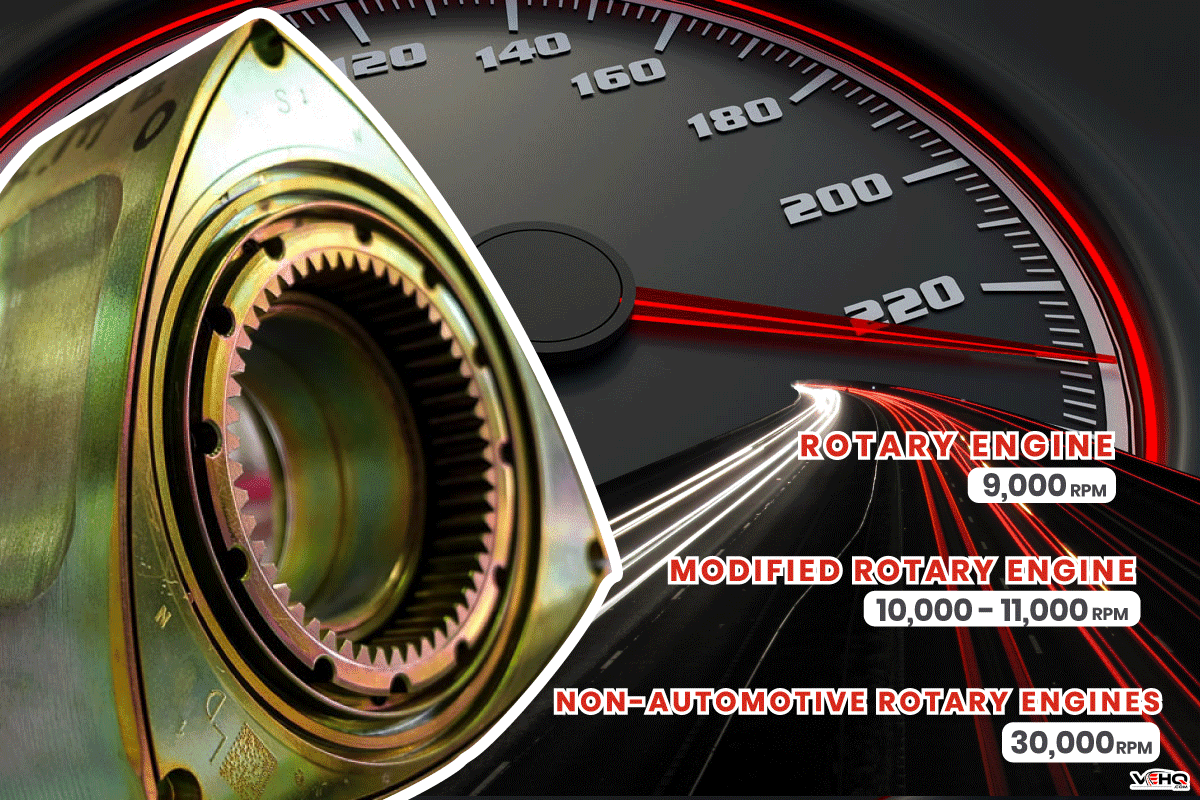
What Is The Max RPM For A Rotary Engine?
Compared to piston-cylinder engines, rotary engines are pretty rare. Nevertheless, rotary engines still have a cult-like following among many automotive performance and racing enthusiasts.
This reverence in the automotive community continues a decade after the discontinuation of the last rotary-powered production car in 2012, the Mazda RX-8.
The rotary engine - known as the Wankel engine by its German inventor, Felix Wankel - was initially designed to have minimal vibrations compared to piston-cylinder engines.
Due to the absence of reciprocating masses (pistons), however, rotary engines also gained one particular characteristic - a high revolutions-per-minute (RPM) capacity.
So how high do rotary engines rev?
To set a baseline for our discussion, most modern gasoline-powered piston-cylinder engines reach their factory-set redline at 6,000 RPM. Diesel-powered cars, in turn, usually hit their redline at 3,500-4,500 RPM.
Rotary-engine performance cars like the Mazda RX-7 and RX-8 have factory-configured redlines ranging from 7,000 to 9,000 RPM. By tuning and rev limiter removal, some of these cars' owners rev their engines beyond 10,000 RPM.
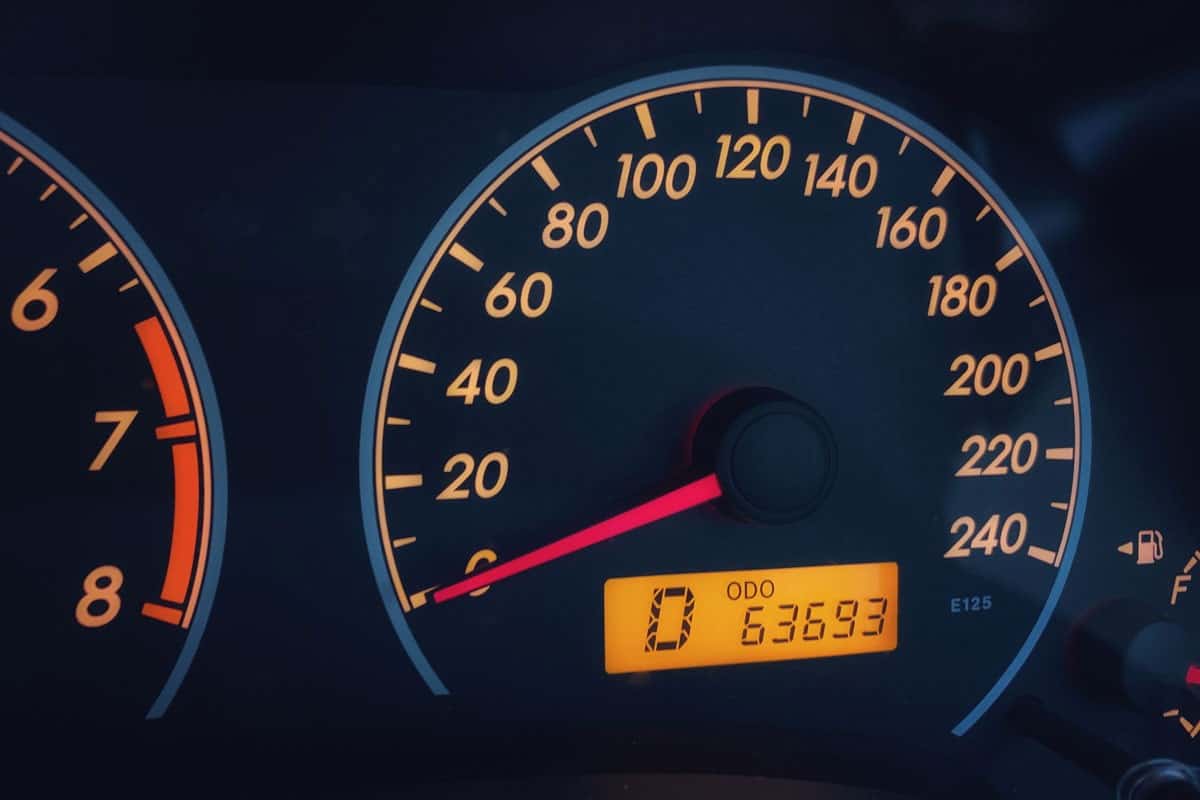
How High Can You Rev An RX8?
The Mazda RX-7, produced from 1978 to 2002, has a stock redline between 7,000 and 8,000 RPM, depending on the year model and trim.
On the other hand, the Mazda RX-8, produced from 2003 to 2012, had a 9,000 RPM redline for manual transmission (M/T) and 7,500 RPM for automatic transmission (A/T) models.
The lower redline for the A/T models is due to the mechanical limitations of the torque converter, not the engine itself.
Many rotary engine enthusiasts, however, have made aftermarket modifications to churn out higher RPMs and power output without blowing their engines up.
These include changing to lightweight rotors, flywheel balancing, and many other expensive alterations.
With these modifications, some RX-7s and RX-8s can reach 10,000 to 11,000 RPM.
Wankel Engine RPM
Although the rotary engine's most popular application has to be in Mazda's sports cars, Wankel's invention has other niche applications.
Here are some of the other ways Wankel's engines are used:
- Motorcycles
- Speedboats
- Helicopters
- Uncrewed Aerial Vehicles (UAVs)
- Remotely Piloted Vehicles (RPVs)
- Model Engines
Some enthusiasts have tried running model rotary engines up to approximately 30,000 RPM in a controlled workshop or laboratory setting.
Watch the video below to see how one of these high RPM tests was done:
How Does A Rotary Engine Work?
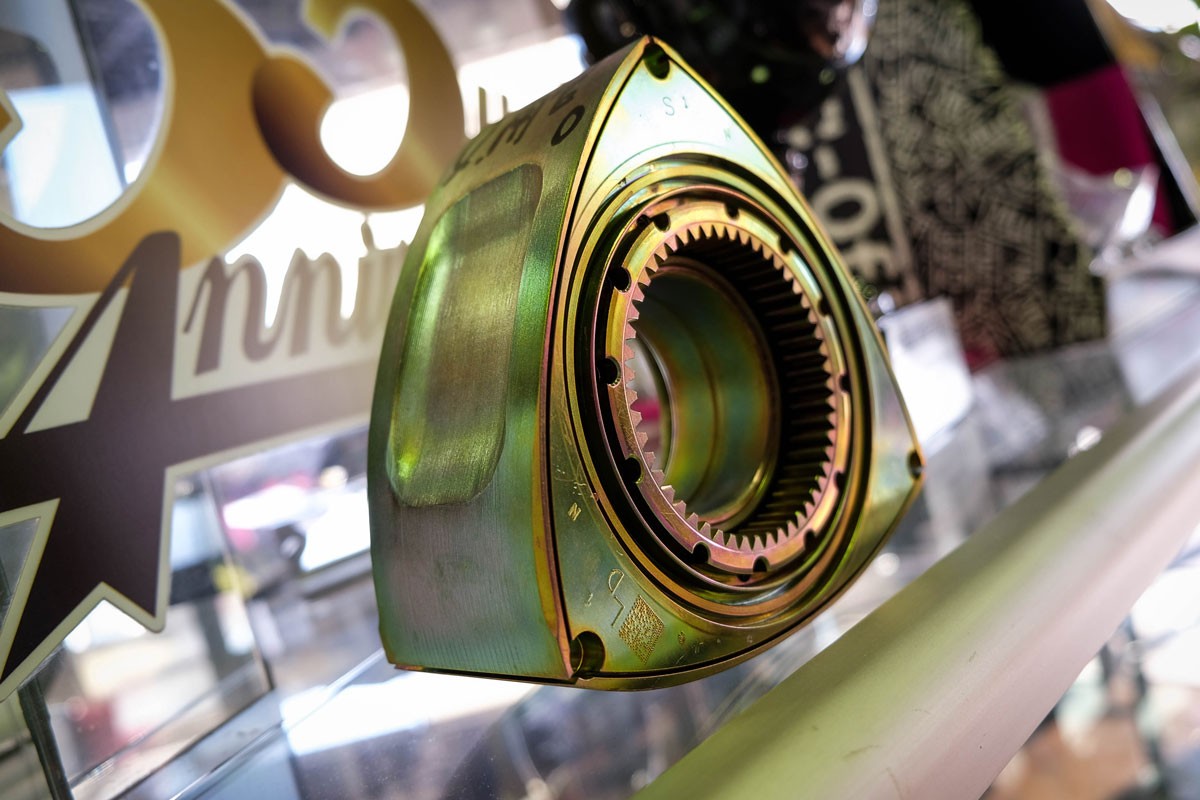
In 1924, a 22-year-old German engineer named Felix Wankel started his laboratory research and development of an internal combustion engine.
This engine did not use reciprocating masses such as pistons to produce power. Instead, he wanted the engine to complete a four-stroke combustion cycle using a rotating mass.
After three decades of work, Wankel completed his first rotary engine design in 1954, which was tested in 1957. From then on, this rotary engine was also called the Wankel engine.
In contrast to conventional engines of that time, the Wankel engine used a triangular rotor instead of pistons.
The intake, compression, power/expansion, and exhaust strokes occur in the space between the engine housing and this rotor (affectionately called a "Dorito" by some rotary engine experts).
As the rotor rotates, it imparts its rotational force to an eccentric shaft (in place of the traditional crankshaft), thereby providing power through the transmission and, eventually, the vehicle's wheels.
What Are The Main Components In A Rotary Engine?
A Wankel rotary engine has three main parts, making it much simpler in design compared to a piston-cylinder engine.
- Rotor
- Housing
- Eccentric crankshaft
The rotor has three convex sides (hence the "Dorito" shape) with hollowed-out pockets on each of the three side faces for increased displacement.
At the center of the rotor is an inward-facing gear that meshes with the eccentric shaft's outer-facing gears.
The rotor rotates eccentrically while keeping its three apex points in contact with the housing's inner face using apex seals.
This constant contact ensures that the system's combustion strokes, which all happen on each of the rotor's three sides, are isolated.
As the name suggests, the housing contains the rotor and accepts all the inputs needed for the internal combustion process. The housing has air intake ports, exhaust ports, and provisions for spark or glow plugs and fuel injectors.
The eccentric shaft transfers the Wankel engine's produced energy to the transmission, axles, and, eventually, the wheels.
Whereas the conventional crankshaft converts the pistons' up-and-down movement into rotational movement, the eccentric shaft relays the engine's rotation into shaft rotation.
What Are The Strokes Of A Rotary Engine?
As mentioned earlier, the Rotary engine is a four-stroke engine, just like most piston-cylinder cars on the road today. Each of the three concave sides of the rotor goes through all four combustion strokes.
Each time one side of the rotor completes a combustion cycle, the eccentric shaft rotates once. Thus, when one rotor apex makes a complete rotation inside the housing, the eccentric shaft would have rotated three times.
Check out this video for a more detailed and visual explanation of how a rotary engine works:
Rotary Engine Advantages And Disadvantages
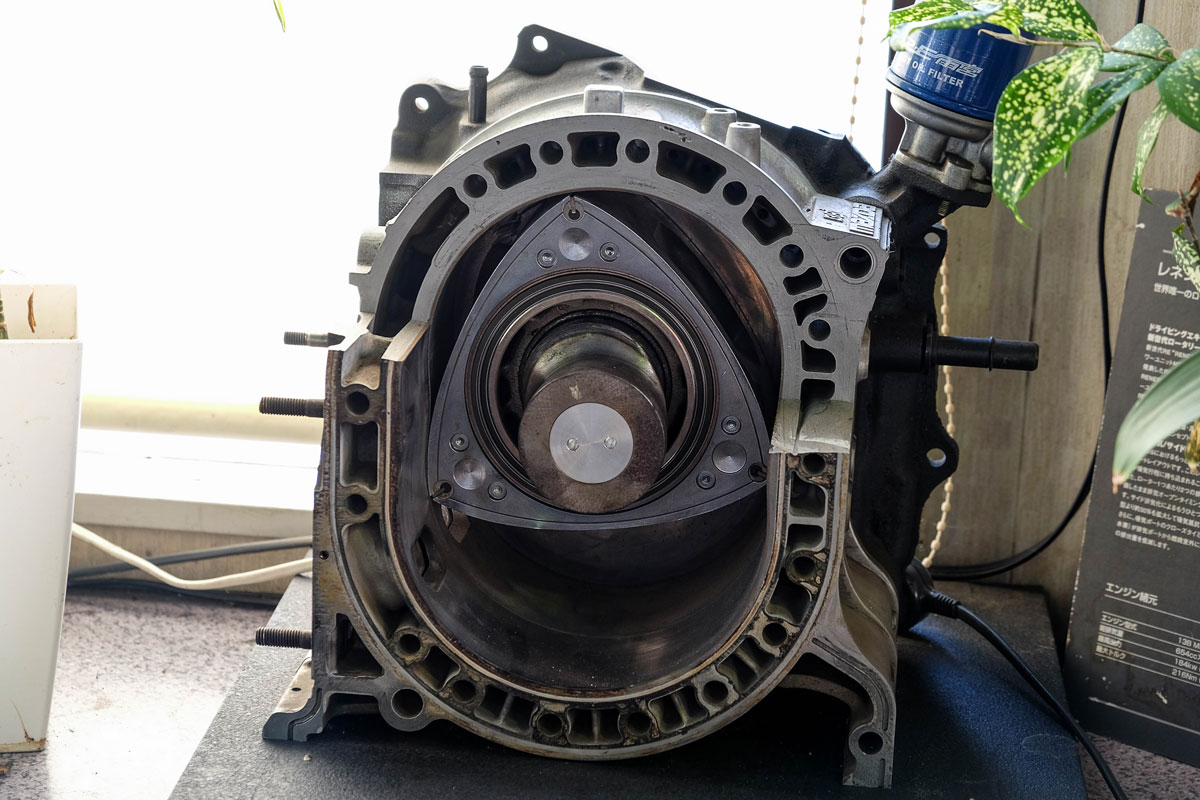
Compared to conventional piston-cylinder engines, Wankel engines have plenty of advantages that stem from their simple design.
However, rotary engines also fall short in some aspects compared to piston engines, which we see in almost every modern internal combustion engine (ICE) vehicle today.
Rotary Engine Advantages
Here are the advantages of the rotary engine over the piston-cylinder engine:
- Simple design - fewer moving parts typically lead to higher reliability. The rotary engine does not need camshafts, connecting rods, or over 40 other moving parts that you usually find in a piston-cylinder engine.
- Smooth engine operation - due to the absence of the pistons' up-and-down reciprocating masses, Wankel engines run more smoothly. For the same reason, rotary engines can rev very high compared to most piston-cylinder engines.
- Higher power-to-weight ratio - due to the simplicity of the design, rotary engines are pretty light. Moreover, a rotary engine typically produces more power than a piston-cylinder engine with the same displacement. For example, the legendary Mazda 13B-REW turbocharged rotary engine gave the 1999-2002 RX-7 a whopping 280 h.p. using only 1.3 liters of engine displacement.
- More linear power delivery - Unlike a piston's power stroke that lasts for only one of its four movements per cycle, a rotor's power delivery lasts longer due to its rotational movement. This longer delivery results in a much smoother power output throughout the RPM range.
- Compact size - due to the simple design and high power-to-weight ratio, the rotary engine is more compact than piston-cylinder engines with the same power output. This compactness makes the vehicle lighter and allows for easier packaging and shipment.
Disadvantages Of Rotary Engines
Here are the drawbacks of rotary engines to conventional piston-cylinder engines.
- Poor fuel economy - rotary engines typically run rich in terms of the fuel-to-air mixture. Moreover, Wankel engines have lower compression ratios compared to piston-cylinder engines. This combination leads to more unburned fuel coming out of the exhaust and often to a lot of backfiring.
- High emissions - Due to the exhaust's unburned fuel and engine oil, rotary engines are less environment-friendly than modern piston-cylinder engines.
- Rotor seals - combustion only happens in one section of the rotary engine's housing, thus leading to temperature differences within the engine. As the rotor rotates, its apex seals undergo constant contraction and expansion, which leads to poor sealing and inefficient power production.
- High oil consumption - rotary engines inject engine oil directly into the housing to lubricate and maintain the apex seals. This oil gets burned and expelled through the exhaust port in the process, thus leading to more frequent oil top-ups.
What Cars Have Had A Rotary Engine?

Apart from the Mazda RX7 and RX8, some of the car's rotary engines have powered.
- Skoda 1000 MB (concept only)
- Wankel Spider
- Curtiss-Wright Mustang
- Mazda Cosmo
- NSU Ro 80
- Citroen M35
- Mercedes-Benz C111-V1
- Chevrolet Corvette XP-897GT
- Mazda Rotary Pickup (REPU)
- Mazda 787B
Although rotary engine vehicles have been around since the 1960s, one can't help wondering why they aren't as commonplace as piston engines today. After all, the Mazda rotary engine cars have proven the engine's mettle, even in prestigious races like the 1991 Le Mans.
Well, the main culprit is the rotary engine's high emissions. The 2012 Mazda RX-8, for example, couldn't meet EURO 5 emissions regulations anymore.
Nevertheless, in January 2023, Mazda officially brought back the rotary engine in the new MX-30 R-EV. However, the rotary engine in this crossover electric SUV is only meant to extend the vehicle's driving range by charging the traction battery.
To Finish
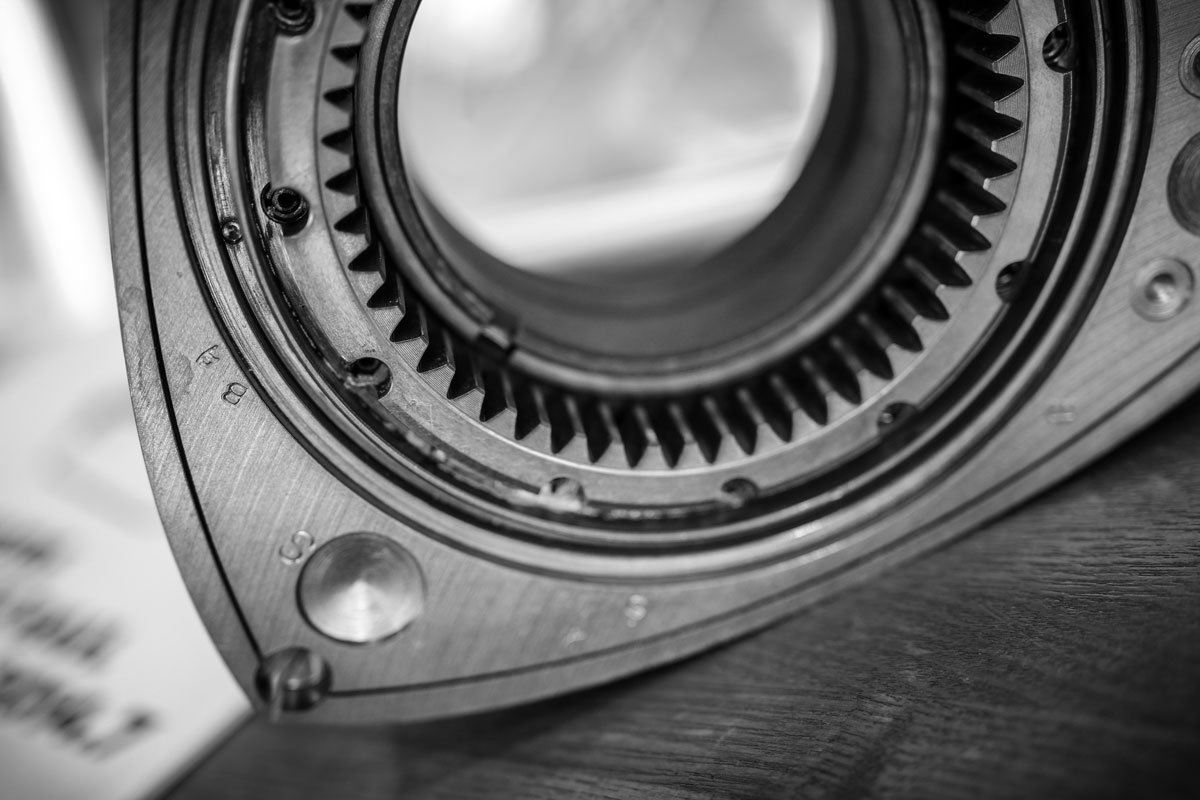
Rotary engines can reach higher RPMs in automotive applications than most piston-cylinder engines. For example, a modified Mazda RX7 or RX8 can reach 10,000 to 11,000 RPM in real-world settings.
Some enthusiasts have achieved up to 30,000 RPM from small model rotary engines in controlled laboratory or workbench experiments.
Thank you very much for reading. We hope we were able to help you understand more about the RPM limit of rotary engines.
And while we have your attention, check out these related articles:
